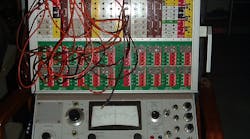Just recently, I received a note from Professor Yannis Tsividis of Columbia University, who happened to read a blog I wrote in 2007 on analog computers.
In that blog, I ended by saying that “I sometimes wonder if we shouldn’t bring back a modern version of an analog computer.” Professor Tsividis wanted to alert me to the fact that he and his colleagues had done just that. Indeed, they created a single-chip analog/hybrid computer. It’s described in detail in an IEEE paper published last year.1 This is positive proof that perhaps analog computers still have a place in computing.
For those of you not familiar with analog computers, let me elucidate. Analog computers solve problems by representing variables and constants with voltage. These quantities are then manipulated by electronic circuits that perform math.
Analog computers are designed primarily to simulate physical systems. This is done by writing the math equations describing the processes and functions of the system. Analogs are particularly good at calculus, making differential equations almost trivial. Then a collection of computing circuits is assembled to perform the math. Voilà! A nearly instant solution. By playing with the variables, you can try out different conditions and scenarios.
The basic computing circuit in an analog computer is the op amp. It can be configured as a summer, inverter, or integrator. Other common circuits include coefficient pots, multiplier/dividers, and logarithmic amplifiers. All of these circuits are commonly interconnected with pluggable wires on a large patch panel.
Evolution of Digital
Analog computers peaked back in the 1960s and 1970s. Though digital computers were highly developed by that time, they were still too slow for some math operations and especially for simulating large systems like aerospace hardware or complex chemical processing plants. They played a major role in the Apollo space program, simulating spacecraft dynamics and control systems.
During that period, an analog computer and a digital computer were combined to form a hybrid computer. Big problems were divided up into segments suited to each type of computation, with the digital side performing slow and accurate calculations while the analog did the faster complex math simulations with less accuracy. The two computers communicated with one another via analog-to-digital and digital-to-analog converters (ADCs and DACs, respectively).
Eventually, though, digital computers got faster and better software came along, pushing analog computers down the road to near oblivion.
Back to the Analog Future
Analog computers were always fast but were not always accurate. They suffered from op-amp drift and offset, component tolerances and variables, and other traditional analog-circuit maladies. Today, op amps and other components are better than ever, so a superior analog computer is very achievable. The main question is: “Would it be viable, given today’s fast and cheap processors?” Probably not, but one could make the case for special versions to solve unique problems.
Professor Tsividis and his colleagues pretty much validated that approach by creating an analog/hybrid computing circuit on a single chip. Using 65-nm CMOS, the computer is capable of solving nonlinear differential equations up to the 4th order. Analog blocks like the op amps operate class AB and have digitally assisted calibration. Computational accuracy is in the 0.5% to 5% range, with solution times from less than a microsecond to several hundred microseconds.
The article1 only describes a 4th-order computer, but today Tsividis and crew now have a 16th-order chip. With two of them on a board, they have a 32nd-order computer that interfaces with a laptop via a USB port. Such a system can solve some serious problems on a desktop—quite a change from the big analog/hybrid systems of the past that filled a room with a raised floor.
Generally speaking, analogs are still a good solution for some problems. Nevertheless, it doesn’t seem likely we will ever see a commercial general-purpose analog computer again.2 But special computers could easily be built with modern circuits at reasonable cost. Congrats to Professor Tsividis and his group for proving that analogs still have a place.
References:
1. N. Guo, Y. Huang, T. Mai, S. Patil, C. Cao, M. Seok, S. Sethumadhavan, and Y. Tsividis, "Energy-Efficient Hybrid Analog/Digital Approximate Computation in Continuous Time," IEEE Journal of Solid-State Circuits, vol. 51, no. 7, pp. 1514-1524, July 2016.
2. You can still buy a compact desk top analog from Comdyna. Called the GP-10, it has eight op amps, coefficient pots, and some multipliers/dividers, plus an internal power supply. It’s the successor to the popular GP-6, which has been around since 1968.


